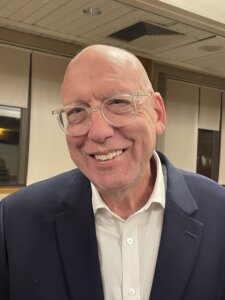Intermarriage Will Shape a New American Judaism

Graphic by Angelie Zaslavsky
When Rabbi Seymour Rosenbloom, a retired rabbi from Elkins Park, Pennsylvania, performed an intermarriage ceremony for his stepdaughter and her fiancé in 2014 more than a glass got shattered at the end of the wedding ceremony. Rabbi Rosenbloom’s membership in the Rabbinical Assembly wound up in pieces as well. In December 2016, the rabbinical body expelled him for disobeying the ban on rabbinic officiation at intermarriages. Not only officiating; also attending intermarriages, even those of close relatives, is asur (forbidden).
And now, the intermarriage-performing Conservative rabbis, or those who aspire to do so, are slowly coming out of the closet.
Something else is being smashed into pieces – and that is the traditional division between the American Jewish denominations.
Soon, though there will continue to be one Jewish people, there will be two American Judaisms. Here’s how it could look.
Moving off the map are:
The “Rhett Butler” Jews: These are the Jews who are vigorously unaffiliated and unconnected to Judaism and the Jewish community. They have been immune to even the most creative outreach efforts. They are the “Rhett Butler” Jews, because they have told the American Jewish community: “Frankly, my dear, I don’t give a damn.” They will be off the mattering map of American Judaism. Said with sadness, not with anger.
The Haredim — their polar opposites are the so-called “black hat” ultra-Orthodox Jews who have largely rejected modernity. They are growing demographically. But, they will also wind up off the communal map – simply because they will hold little in common with the vast majority of American Jews.
Again: said with sadness, not with anger.
Who will be left on the map of American Judaism?
On the right: a very thick stew, consisting of Yeshiva University; modern Orthodoxy; the inclusive, open Orthodoxy of Yeshivat Chovevei Torah; and right wing Conservative Jews, including Conservative rabbis who will not be open to performing marriages between Jews and non-Jews.
Their communal standards? A more or less strict adherence to Halacha. An insistence on matrilineal descent as the determining factor of Jewish identity. Intermarriage as taboo.
On the left: an equally thick stew, consisting of center-left Conservative (including some rabbis who will perform marriages between Jews and non-Jews), Reform, Reconstructionist and renewal Jews.
Why will this happen? Because the demographic inertia that maintained Conservative Judaism as the default affiliation of the Jewish suburbs has broken down. Orthodox and Reform Judaism’s assumptions have both proven to be historically and sociologically viable. The non-Orthodox religious landscape shares a common acceptance of women rabbis, of LGBT rabbis, and the increased use of musical instruments in Conservative synagogues on Shabbat.
On a rabbinic level, many of those Jews already have the same teachers, read the same books, and find inspiration in the same thinkers. They even already have an annual convention. It’s called the courtyard of the Shalom Hartman Institute in Jerusalem, where every July, rabbis of different flavors study, learn, and (perhaps most important) hang out together. Even the modern Orthodox/open Orthodox Jews who study at Hartman are part of this new, emerging movement. The communal standards? There will be widespread acceptance, and/or understanding/, and/or tolerance – or, at the very least, accommodation of the intermarried and their families.
Some rabbis will revive the ancient designation of the ger toshav, the “resident alien” who dwells within a Jewish community and who has no other religious identity. Those rabbis will get creative. They will designate the sympathetic, but as yet unconverted, gentile spouse as a ger toshav. They will figure out new kinds of ceremonies for those couples.
Jewish identity? Non-lineal — the child of a Jewish parent — either parent – who is raised and educated as a Jew will be considered a Jew.
Is this hard to imagine? Perhaps.
But, take a look at the edges of the various movements. Look at the places where one movement’s right wing rubs up against another movement’s left wing.
The ideological boundaries have liquefied. There are rabbis in classical Reform congregations who do not perform intermarriages; there are rabbis in Reconstructionist synagogues who do; there are Conservative rabbis who don’t, and there are others who chafe at the ruling that they may not.
It is a mess — a holy mess. The two Ms — modernity and market share – will ultimately prevail.
So, two American Judaisms — the Orthodox, and the non-Orthodox.
Shrinking memberships and communal coffers will encourage more Reform and Conservative synagogues to merge, especially in smaller communities. Jews will learn to pray together more. Jewish kids will be able to socialize with each other more. We will need a common non-Orthodox Jewish vocabulary and grammar, and that might even drive up educational standards.
It is conceivable that the non-Orthodox seminaries will consider increased cooperation, even consortiums, especially in places like New York and Los Angeles, where they already live and teach in close proximity to each other. 118 city blocks separate Hebrew Union College-Jewish Institute of Religion from the Jewish Theological Seminary of America. To not share resources is actually wasteful – of human resources, potential relationships, and great teachers of Torah. But, as more Conservative rabbis hear glasses broken at intermarriage ceremonies, it will be far more than glass that gets shattered.
Our assumptions about the boundaries of movements and ideologies will be shattered as well. We just don’t know, yet, if at the new denominational unions we will be yelling “mazel tov!”
Rabbi Jeffrey K. Salkin is an author and columnist. He serves as the senior rabbi of Temple Solel in Hollywood, Florida. His new book, “The JPS B’nai Mitzvah Torah Commentary,” will be released in April.
















